Hiking or Backpacking in Minnesota? Details to Explore Your Way
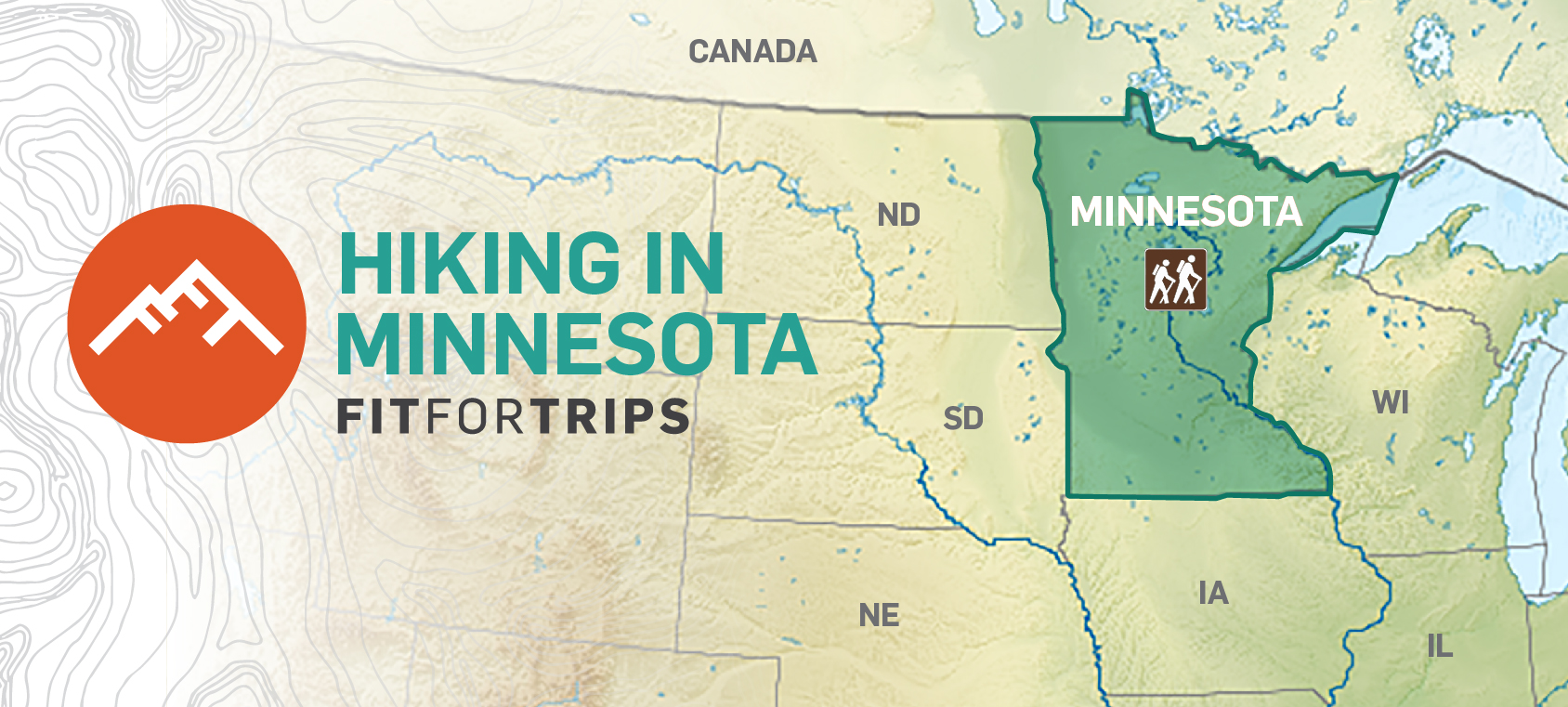
Michelle Schroeder, founder and lead instructor of Backpack the Trails, joined us to give detailed insight on the incredible hiking and backpacking that can be experienced in Minnesota. Michelle has 25+ years of experience backpacking around the globe, including the Canadian Rockies, California’s Lost Coast, New Zealand, Iceland, the Grand Canyon, a thru-hike of the John Muir Trail, and, of course, the deep North Woods of Minnesota.
An environmentalist at heart, Michelle shared that being in wilderness is what made her love and want to protect the environment. She did conservation work for about nine years before circling back to what compelled her to want to protect the environment in the first place – being in it. Today, she remains an active voice for conservation efforts, and serves as a board member on the Border Route Trail Association in Minnesota. Guiding wilderness trips with Backpack the Trails, she focuses on teaching backcountry skills to her clients in Minnesota, Michigan, and all over the United States.
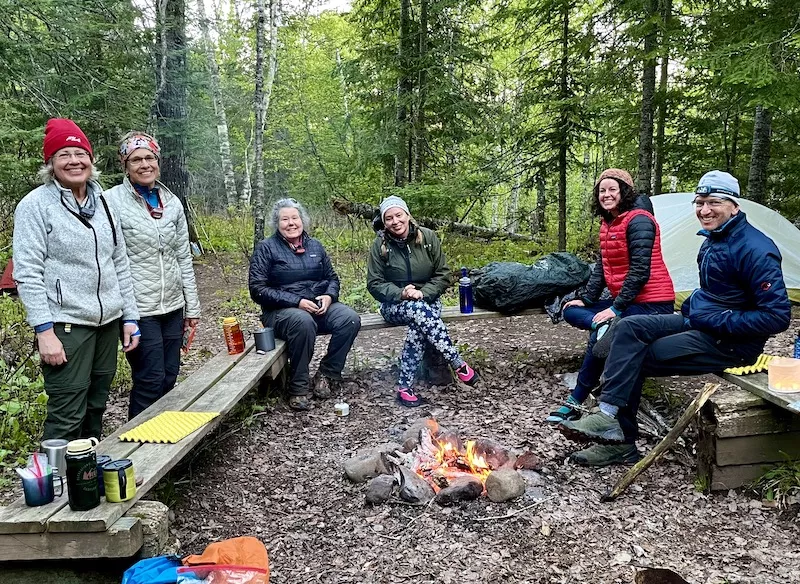 First beginner trip of 2021, late May. Clients enjoying a warm campfire at Durfee Creek Campsite.
First beginner trip of 2021, late May. Clients enjoying a warm campfire at Durfee Creek Campsite.
Getting prepared to hit trails like these requires more than research and gear. Properly preparing your body for the extra weight of a pack, long miles, and difficult terrain is important. If you need help getting in shape to tackle a hiking trip, check out Fit For Trips’ custom training programs or schedule a free fitness consultation with Marcus Shapiro.
And so, we started Michelle off with our first, burning question…
Are There Mountains in Minnesota?
We actually have a range called the Sawtooth Mountains, which are really small mountains – more like big hills. So, Minnesota is not totally flat. While you won’t get alpine vistas, the views are still beautifully sweeping, and there are plenty of trails to thoroughly enjoy here.
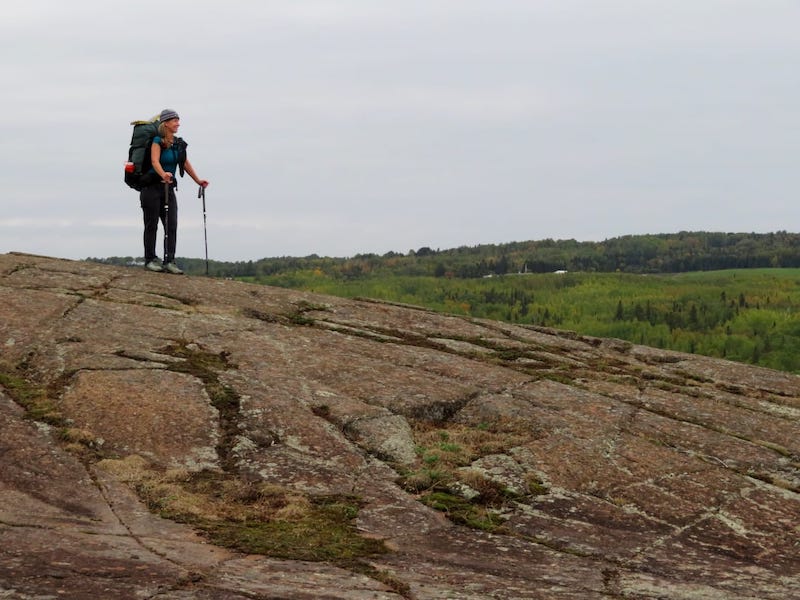 Michelle on the Pincushion Mountain Overlook on Superior Hiking Trail mid-summer.
Michelle on the Pincushion Mountain Overlook on Superior Hiking Trail mid-summer.
Still, when standing on Eagle Mountain (Minnesota’s highest point at 2,301 ft.), Pincushion Mountain or the Palisade Head sheer rock face, looking in all directions, it does look like mountains cascading down to Lake Superior. It’s absolutely stunning. This area is where glaciers sheared off the Sawtooths, what used to be fairly tall mountains. These features are in the northeast corner of the state, tracing the North Shore of Lake Superior. However, compared to mountains in other states, they’re not real mountains.
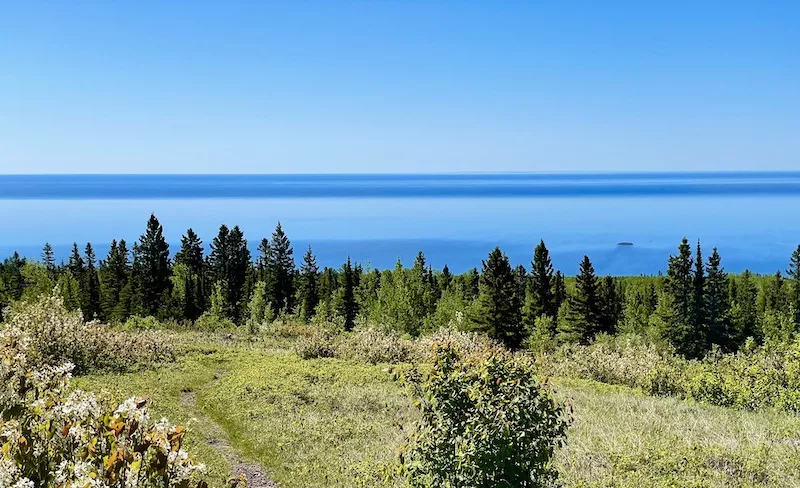 View of Lake Superior from Wildflower Hill. On Superior Hiking Trail north of Grand Marais (meaning ‘Great Swamp’ in French).
View of Lake Superior from Wildflower Hill. On Superior Hiking Trail north of Grand Marais (meaning ‘Great Swamp’ in French).
Many of our trails wind through undulating woods. The terrain in northeastern Minnesota makes for surprisingly rugged trails. Some people prefer being in deep woods to big alpine territory, enjoying the chance to be a little bit more introspective. Nature is often a little closer, too. You’ll see and hear birds and other animals that are a lot closer than in an alpine environment. Bonus: It also makes the contrasting big views that much more stunning.
People don’t even realize that there’s that kind of rugged beauty in Minnesota. For me, it’s really thrilling to share that with people, to see them experience it, to see their expression, to see how it changes people. It’s fantastic!
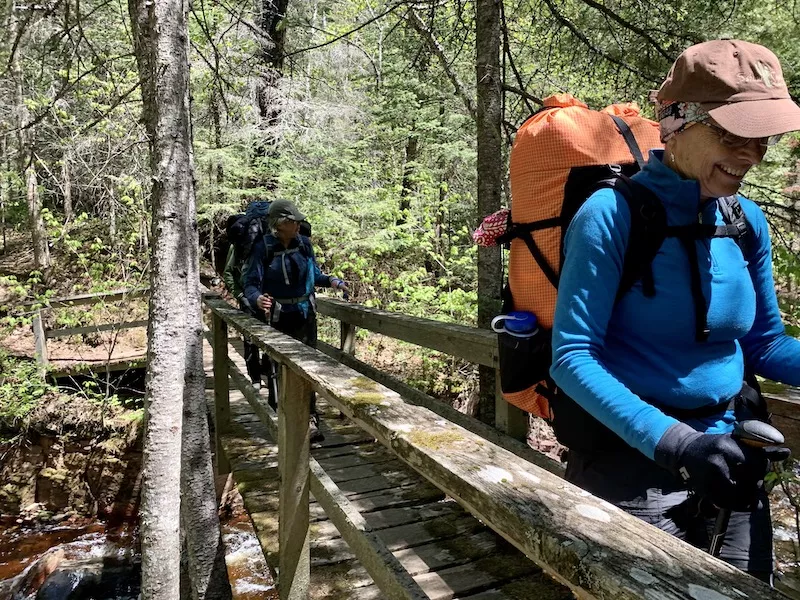 First beginner trip of 2021 in late May. Folks from Massachusetts and Illinois trusting Michelle’s guiding skills.
First beginner trip of 2021 in late May. Folks from Massachusetts and Illinois trusting Michelle’s guiding skills.
I like taking people out there for those experiences. I love sharing that stuff, the physicality of it. Hiking and backpacking are my ways to stay in shape. But I also enjoy helping people fall in love even further with the environment, so that they, in turn, might wish to protect it. Guiding is my way of still being an environmental advocate.
The Minnesota Triple Crown
I’ve hiked all over the world, but what I love about hiking and backpacking in Minnesota is the beauty and experience in nature you can have right here. It’s unique to this part of the world, and right in Minnesota, hikers can experience it for hundreds of miles. We have long trails here, like in other parts of the U.S. and the world. The Superior Hiking Trail, the Border Route Trail, and the Kekekabic Trail connect to create what Minnesotan backpackers call our Triple Crown.
If you’re flying into Minnesota and don’t have time to cover the entire state, but want to hike with some effort, I’d recommend spending five or six days just exploring these three trails and enjoying the physical effort of a moderate-to-hard hike.
#1 The Superior Hiking Trail (SHT)
This beautiful trail runs 310 miles along what we call the North Shore in Minnesota. It runs all along Lake Superior from the Canadian border to south of Duluth, to the Minnesota-Wisconsin border. It’s mostly boreal forest, with lots of great viewpoints. Be sure to check out the spur trails for some of the biggest views. There are many smaller roads that cross the SHT, with over 50 trailheads, so a person can easily choose a specific stretch to explore.
 Backpack The Trails beginner trip hikers standing at the Superior Hiking trailhead.
Backpack The Trails beginner trip hikers standing at the Superior Hiking trailhead.
I teach people how to backpack on the SHT, before I take them on more technical trips. Sometimes, people translate the backpacking accessibility on the SHT to more well-known, heavier-use areas, where they inevitably encounter a permitting system requiring reservations months in advance. Those permits serve to manage the number of people on the trail and, thus, to preserve the trail’s integrity. The Superior Hiking Trail is the most popular backpacking trail in Minnesota and it’s not regulated like that at all. It’s free. You just hop on; you don’t need permits.
 Backpack The Trails clients overlooking the Kadunce River in June. Beginner trip on the Superior Hiking Trail.
Backpack The Trails clients overlooking the Kadunce River in June. Beginner trip on the Superior Hiking Trail.
Visitors with limited time might just pick a section of the Superior Hiking Trail. Their Facebook page has a ton of recommendations based on people’s favorite hikes. I would focus on anything between Two Harbors and the northern terminus. While the southern stretch of the Superior Hiking Trail isn’t as hyped as the northern sections, I still think it’s really beautiful.
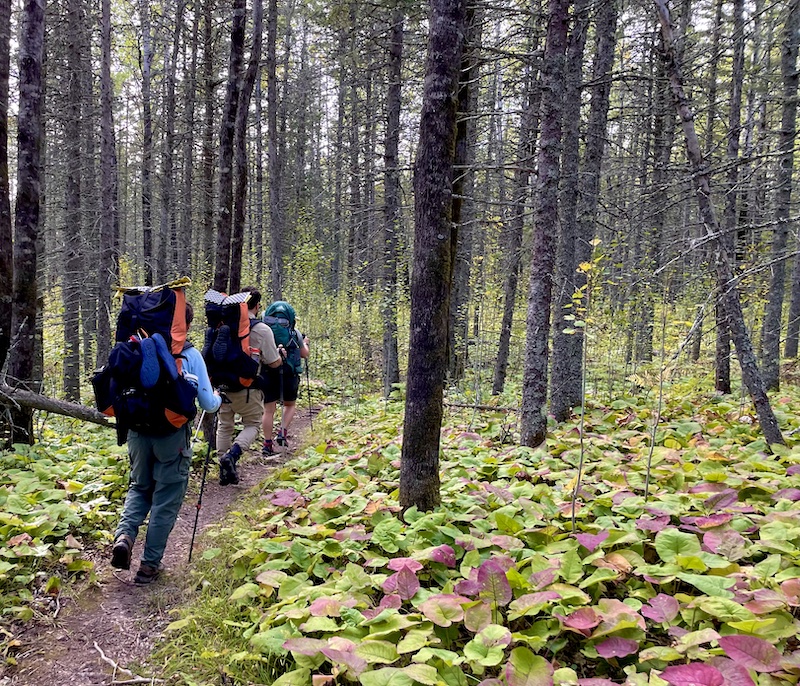 Backpack The Trails beginner trip hiking thru a spruce forest in mid September on the SHT.
Backpack The Trails beginner trip hiking thru a spruce forest in mid September on the SHT.
#2 The Border Route Trail (BRT)
I think this is the absolute gem of Minnesota, and it’s my number-one suggestion for people with advanced backpacking skills visiting the state. This trail is 65 miles long and connects to the northern terminus of the Superior Hiking Trail, following the US/Canadian border. The BRT crosses amazing terrain, traveling through the Midcontinent Rift System, which is a failed geological rift that formed 1.1 billion years ago.
There are a lot of geological remnants from volcanic and earthquake activity where the tectonic plates there shifted. While the Border Route Trail is similar to the Superior Hiking Trail – rocks, roots, and boreal forest – everything is much more dramatic, remote, and a lot tougher than the Superior Hiking Trail, with a lot more elevation gain and loss as well as trail-finding skills. Both the beauty and ruggedness take people by surprise.
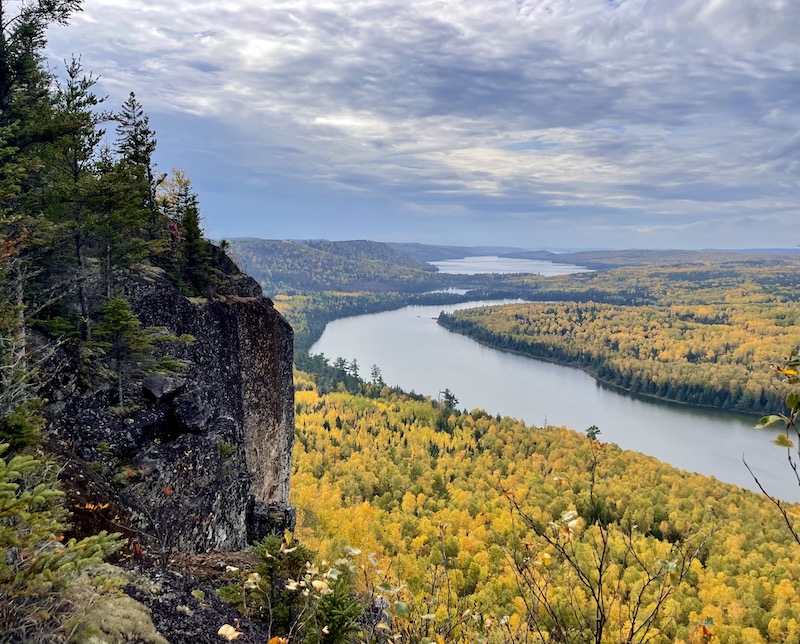 Iconic image outcropping of Rose Cliffs and Spire on Border Route Trail. Canada to the right of Rose Lake and U.S. on the left.
Iconic image outcropping of Rose Cliffs and Spire on Border Route Trail. Canada to the right of Rose Lake and U.S. on the left.
The BRT crosses the magnificent Boundary Waters Canoe Area Wilderness in Minnesota, which, as of 2021, is one of only seven International Dark Sky Sanctuaries in the world. You’ll be high atop a palisade on the U.S. side, staring directly across incredibly beautiful border lakes at even more stunning palisade cliffs on the other side, in Canada’s Quetico Provincial Park – taking in views of hundreds of miles of just pure, undulating forest. Completely uninterrupted, just magnificent and beautiful. You can often see the Northern Lights there. The Boundary Waters itself is renowned for incredible canoeing, but there are several trails within the BWCAW, including the Border Route Trail.
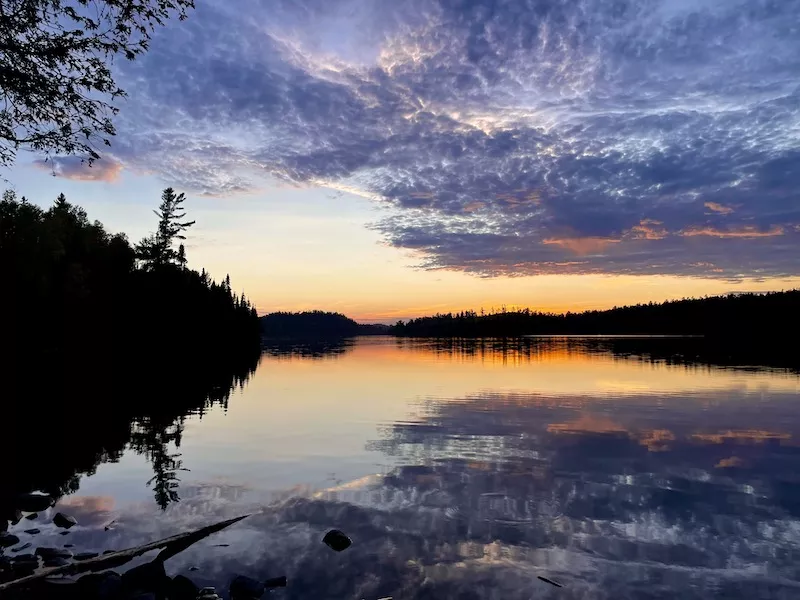 Sunset behind Daniels Lake in late September on Border Route Trail.
Sunset behind Daniels Lake in late September on Border Route Trail.
#3 The Kekekabic Trail
This is the third leg of our Triple Crown. The Kekekabic, also called the Kek, is 41 miles long. It, too, travels through the remote Boundary Waters, ending at Snowbank Lake in Ely.
So, with these three trails, you’re covering the entire stretch of Lake Superior in Minnesota and crossing the entire Boundary Waters on foot, and that is our Triple Crown. It’s stunning.
To thru-hike any of these trails is going to take some time. The Superior Hiking Trail commonly takes about three weeks with planned zero days. The Border Route Trail will take five or six days. The Kek is going to take about three to four days.
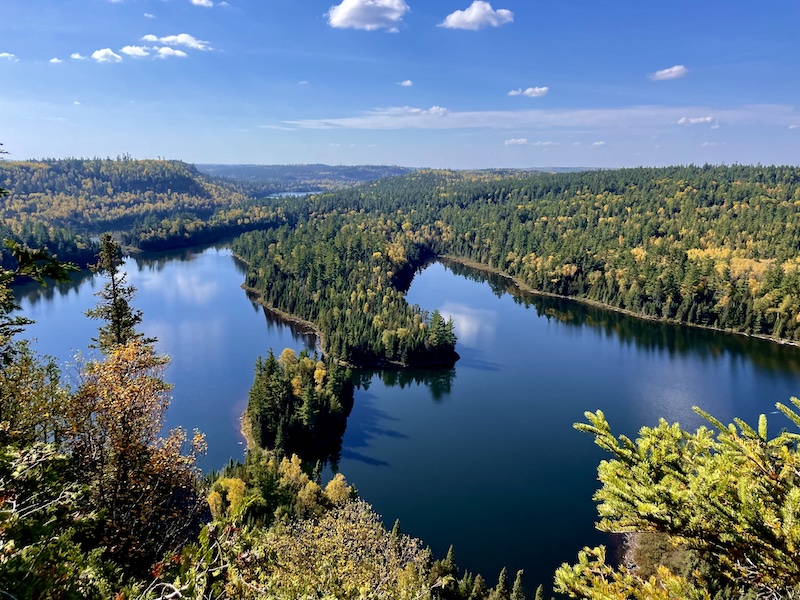 View of Watap Lake atop a palisade on the Border Route Trail in late September. Canada to the right and U.S. to the left of the lake. Looking west.
View of Watap Lake atop a palisade on the Border Route Trail in late September. Canada to the right and U.S. to the left of the lake. Looking west.
Best State Parks to Visit in Minnesota
I always feel like it’s unfair to single out specific places, but I’ll share a few great State Parks. Minnesota has 66 state parks, so it really depends on what you’re looking for. I’ve been to some of them, although I tend to stick to some of the bigger trails, because I’m more into the backpacking stuff. However, these seven state parks offer stunning hiking trails with a variety of difficulty levels.
- William O’Brien State Park is great for day hikes. It’s along the Minnesota and Wisconsin river border, so you’ll get some beautiful scenery. My segment on the Emmy-Award Winning Minnesota Bound was shot there. If you would like to see more of the Park, start the episode at 5:50.
- Afton State Park, close to the Twin Cities, is great. If you’re looking to hike into a camping spot, you only have to walk about a mile. It’s great for people who want to test out backcountry camping without fully committing to being miles away from the car.
- Judge C.R. Magney State Park is up on the North Shore, featuring the renowned Devil’s Kettle Falls in the Brule River. I love anything north of Grand Marais with all of the waterfalls, and as far as backpacking, Magney is an access point for the Superior Hiking Trail.
- Jay Cooke State Park is just south of Duluth and provides easy access to striking nature. It’s so fun to cross the 200-foot swinging bridge over the wide St. Louis River and hike, cross-country ski, or snowshoe on the many trails. This park is stunning and very popular.
- Tettegouche State Park is another beauty! Lots of cliffs, spectacular viewpoints and easy access to two different waterfalls, including the 63-foot High Falls on the Baptism River. This is one of the places where you can also camp along the shores of Lake Superior at cart-in campsites.
- Temperance River State Park is amazing. You can car camp right on the shores of Lake Superior, or hike my favorite spur trail to see the astounding waterfalls cutting through tight gorges and carved-out cauldrons. That’s a great place to picnic. There’s a little bit of everything here.
- Whitewater State Park in Southeastern Minnesota has great day hikes through wooded bluff lands. We have lots of mosquitoes in Minnesota, but Whitewater State Park has none, because of all of its moving water – there is no standing water – a great reprieve in Summer.
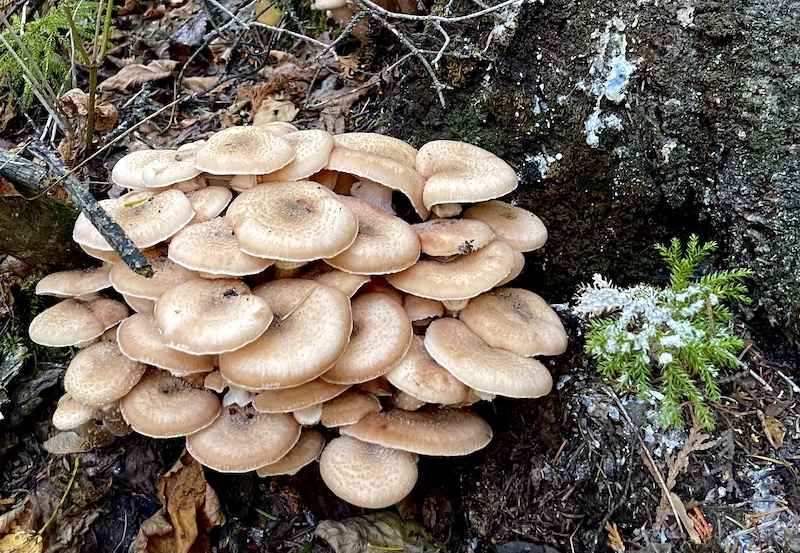 Thirsting from the drought, mushrooms exploding in growth on Border Route Trail from the welcomed rains.
Thirsting from the drought, mushrooms exploding in growth on Border Route Trail from the welcomed rains.
You know, there are at least eight state parks that the Superior Hiking Trail traverses, in addition to crossing private and State land.
Minnesota has a state parks passport, so for those who endeavor to hike all of our State Parks over a span of time, the passport is a fun way to go. You’ll see really special areas in our State, venturing from grasslands with buffalo, to the Driftless Area along the Mississippi River for wide bluff views of karst topography, or from Parks close to The Cities with great cross-country skiing, to rugged trails in Northern Minnesota.
The only national park in Minnesota is Voyageurs National Park, with a lot of canoeing, kayaking, and house-boating. I’m not super familiar with the hiking trails there, but there are a handful of short ones. Your best bet is to refer to the National Park Service for where to hike in Voyageurs.
Honorable mention goes to the Border Route Trail that goes through the Boundary Waters Canoe Area Wilderness, which is overseen by the National Forest Service and the all-volunteer Border Route Trail Association. There are something like 10 or 11 other trails in the BWCAW, which is just stunning.
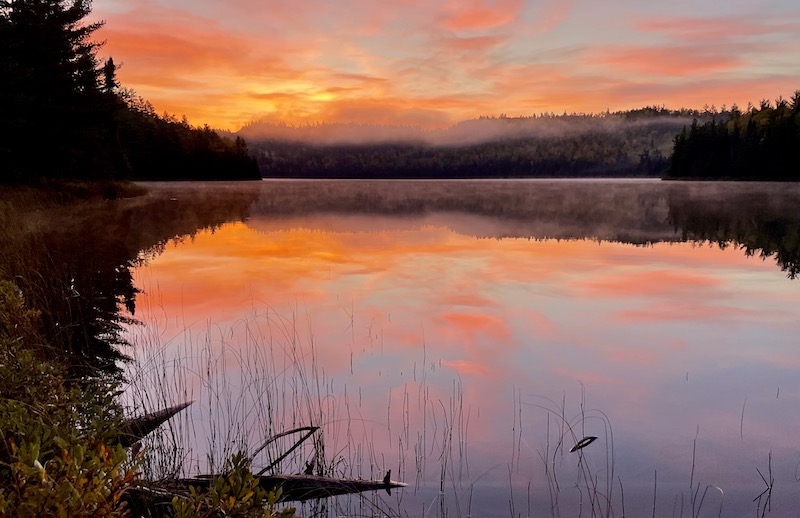 View of Gogebic Lake from campsite on Border Route Trail.
View of Gogebic Lake from campsite on Border Route Trail.
Enjoyable Hikes Near Minnesota’s Major Cities
Twin Cities – St. Paul and Minneapolis
The Grand Rounds Scenic Byway System is a 50mi, paved loop around the Twin Cities. It’s ideal for biking, but people walk and rollerblade it, too.
You can cut the loop into segments or stitch together some of the trails along the Mississippi River, such as the Winchell Trail, an old Native American trail that runs along the river gorge. You could also tie in trails on Pike Island or the trails in Fort Snelling State Park. Lots of great trails along the Minnesota River, too.
Our metropolitan regional parks run by the Three Rivers Park District, are amazing! With over 27,000 acres of parks and trails, all within reasonable driving distance of the metro, there are many great opportunities to explore.
Duluth
I’d recommend checking out several trails – the breathtaking Chester Creek Trail, Amity (East and West), Hawk Ridge, and Lester River – near the extraordinary Seven Bridges Road, all on the northern side of Duluth, with myriad trail-lengths to suit those wanting really accessible trails and more of a scenic walk. This area is also great for cross-country skiing or bird-watching at the Hawk Ridge Bird Observatory.
Part of the Superior hiking trail does cut through the Duluth area, if you’re looking to stay close to that city while still having access to trails.
I’d also suggest a visit to Canal Park. It’s pretty exciting to see the big sea-faring ships sailing in and out, the iconic lift-bridge and lighthouse. Duluth has a great food scene and is family-friendly. It’s awesome.
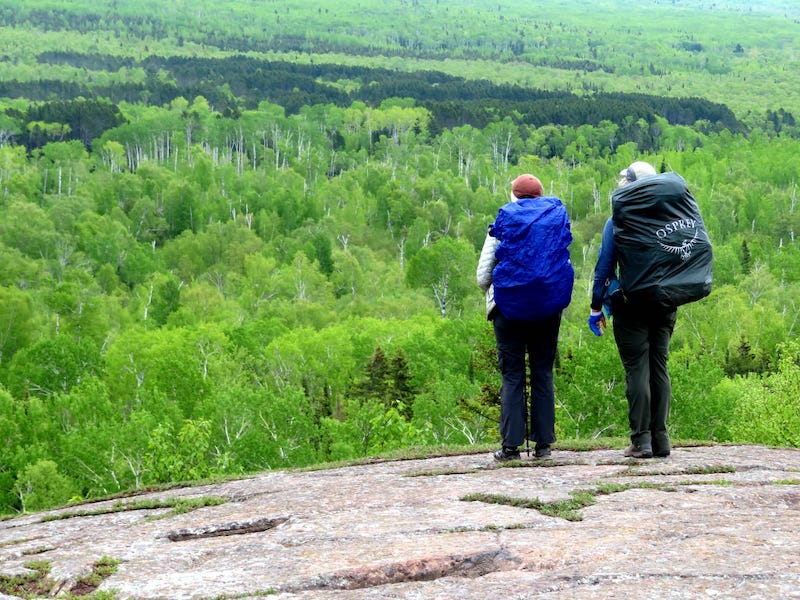 Sister backpackers on Pincushion Mountain at end of section thru hike on SHT in late May.
Sister backpackers on Pincushion Mountain at end of section thru hike on SHT in late May.
Reference Guides for Minnesota Hiking
When exploring a new place, books and reference guides are a great way to read up before you go and check off a list of to-dos while you’re there. There are a few popular guides that people find and reference when researching hiking and backpacking in Minnesota. Here are some of those guides with a sneak peek into why people are using them.
1. 60 Hikes Within 60 Miles: Minneapolis and St. Paul: Including Hikes In and Around the Twin Cities
Minneapolis regularly wins awards for quality of and accessibility to parks and hiking/biking trails. The hallmark of our parks is that a prior politician with great vision required waterfront property along Minneapolis lakes, Minnehaha Creek, and the Mississippi River to be public domain. No one can build right up to the shoreline, which means we have tons of beautiful trails.
The Mississippi National River and Recreation Area runs right through the Twin Cities and offers many miles of hiking trails in both St. Paul and Minneapolis. All of our Twin Cities trails are perfect for fitness, mental health, and socializing. We are so fortunate.
When I bought my house, I told my realtor, “I need to be close to one of the trails.” I can live in the city, but I need to feel like I have a big backyard. And so, I live five blocks from one of the trails right along the Mississippi River gorge, which is incredible.
We call Minneapolis the City of Lakes. It’s a huge part of our identity here. Lots of little sail boats, canoes and kayaks, with hundreds of people hiking or biking around the metro lakes.
2. Hiking the North Shore
This book is pretty popular because the North Shore of Minnesota is just amazing, and is a major tourist destination.
You’ve got beautiful campsites, lots of accessible water, and great viewpoints. You’re close to resorts, state parks, and amenities, too, so it’s really easy to launch a day hike or backpacking trip from there. We also have great shuttle service established up there between trailheads.
There are so many really cute towns along the way, like Two Harbors, and, towards the northern section, lovely Grand Marais, which has been named America’s Coolest Small Town (Budget Travel Magazine), Top 10 Beach Getaways (Outside Magazine), and Next Great Adventure Town (National Geographic Adventure Magazine). There’s a little art colony, a great food scene, awesome architecture, a gorgeous setting, and just an overall good vibe. People are laid back and helpful. When you hike on the North Shore, you get that small town feel with a dash of modern amenities, but there’s still really accessible backpacking and day hiking. It’s really cool.
There are lots of beautiful rivers–around 60 of them–along the North Shore that cascade down to Lake Superior: Temperance River, Tettegouche State Park’s High and Low Falls, Cascade River, and waterfalls like Devil’s Kettle. There are tons of beautiful spur trails and day hikes along all of these rivers. For the folks who don’t want to backpack, the river trails are great for day hikes.
3. Guide To The Superior Hiking Trail
This book pairs up with Hiking the North Shore because there’s a lot of overlap. The people visiting the North Shore for cream-of-the-crop day hikes are hiking on what are referred to as spur trails. Those trails also take you to the Superior Hiking Trail which traces along the North Shore. The Superior Hiking Trail is perfect for backpacking and longer day hikes.
Outside Magazine included the Superior Hiking Trail on a list of the best long(ish) trails in the country in 2018. It’s 310 miles allows you to have an authentic backpacking experience. I think it’s incredible that volunteers built and maintain the Superior Hiking Trail.
4. Hiking the North Country Trail
The North Country Trail stitches together smaller trails from Vermont to North Dakota, and includes Minnesota.
Interestingly enough, it took an act of Congress to include a section that incorporated the full Superior Hiking Trail and the Border Route Trail, connecting this long trail to North Dakota without having to build a whole new stretch. The previously considered section would have gone through a swamp instead of on the beautiful Superior Hiking and Border Route Trails, a lucky save!
A lot of people don’t know yet about the North Country Trail. It’s kind of a newer concept in Minnesota. I have to say that it’s really fun seeing the blended trail markers for the Border Route Trail and the North Country Trail.
5. Hiking Waterfalls in Minnesota
We have so many waterfalls in Minnesota. I’ve no doubt that Grand Portage Falls have a 5-star rating with its broad, cascading water, and as the highest (120 ft) waterfall in Minnesota.
Right in the Twin Cities, Minnehaha Falls, is a definite highlight, and St. Anthony Falls is right in downtown Minneapolis, with magnificent views of the Falls from the historic Arches Bridge, a hike that I show to every visitor.
For other waterfalls in Minnesota, Mankato’s Minneopa State Park boasts the tallest falls in southern Minnesota.
There is also the intriguing 60-foot underground river in Niagara Cave in SE Minnesota. As you head to SW Minnesota, you’re getting into vast, flat farmland, so you are not going to have many waterfalls in that part of the State. That said, Winnewissa Falls in Pipestone National Monument is absolutely lovely. But for the most bang for your buck, head to northeastern Minnesota in the Arrowhead region. You’ll definitely have lots of waterfalls there.
My favorite river and waterfall in Minnesota is Temperance River. It’s got all of these cauldrons, where small rocks in the river swirled around, carving out bowls over eons in the foundational rock. This is in a narrow, roaring gorge that is just beautiful. I encourage visitors on that day hike to go well past the footbridge, to the two sets of open waterfalls. They are upstream almost a mile or so. Definitely worth the walk.
 Morning view of Gogebic Lake from Border Route Trail.
Morning view of Gogebic Lake from Border Route Trail.
Top 3 Things All Hikers Need to Know
I’m a NOLS-certified wilderness first responder, so there’s a lot of stuff I wish everyone knew before hitting the trails for a day hike or backpacking trip.
- Learn what to bring by looking at the Ten Essentials from the National Park Service, and tailor that list to your activity. Yes, equipment is incredibly important. For example, important equipment to bring on the trail is rain gear; a jacket and hiking pants. Prior to your trip, go for a long hike in the rain to test your gear to make sure it works, so that you don’t end up in trouble when far away from help. Wear footwear that is really familiar to you, not something you’re yanking out of the box a week before your trip. Same as the rain gear, take those shoes out for lots of long hikes. The Ten Essentials also include water, first aid, shelter, headlamps, and more.
- The 7 Leave No Trace Principles (™) are also a helpful guide. Principle 1: Plan and Prepare. For instance, be sure you know where you are going and notify someone of your whereabouts. Bring a good, old-fashioned map and compass, as well as GPS navigation. Consider bringing along a satellite messenger for emergencies and have a subscription for it, if needed. And know how to use all of these before you head out.
- Training is incredibly important, in terms of both fitness and experience. I ask clients what they typically do for exercise. I want to make sure they’re picking a trip that’s right for their current fitness and experience level.
My guiding experience has helped me realize that people don’t really know in advance how hard backpacking can actually be. It’s so different from trail running, orienteering, and day hiking. Training ahead of time is crucial and traditional exercise is great: Lifting weights, body weight exercises, running, and stretching.
For trip-related exercise, I tell people that the most important thing for starters is to get those little muscles in your feet ready. You have to get them prepped for lots of compression and for your feet to get used to being stood on for six to eight hours a day.
I then recommend working your way up to carrying a 30-pound pack for multiple day hikes, carrying the pack up and down multiple flights of stairs each time. Do any type of weight training and running. Any and all types of exercise you can do will help with backpacking. Fitness is key. Build up to a long day hike. It’s very important to just make your feet understand what this feels like, to be on them for that long with compression, even just with your body weight.
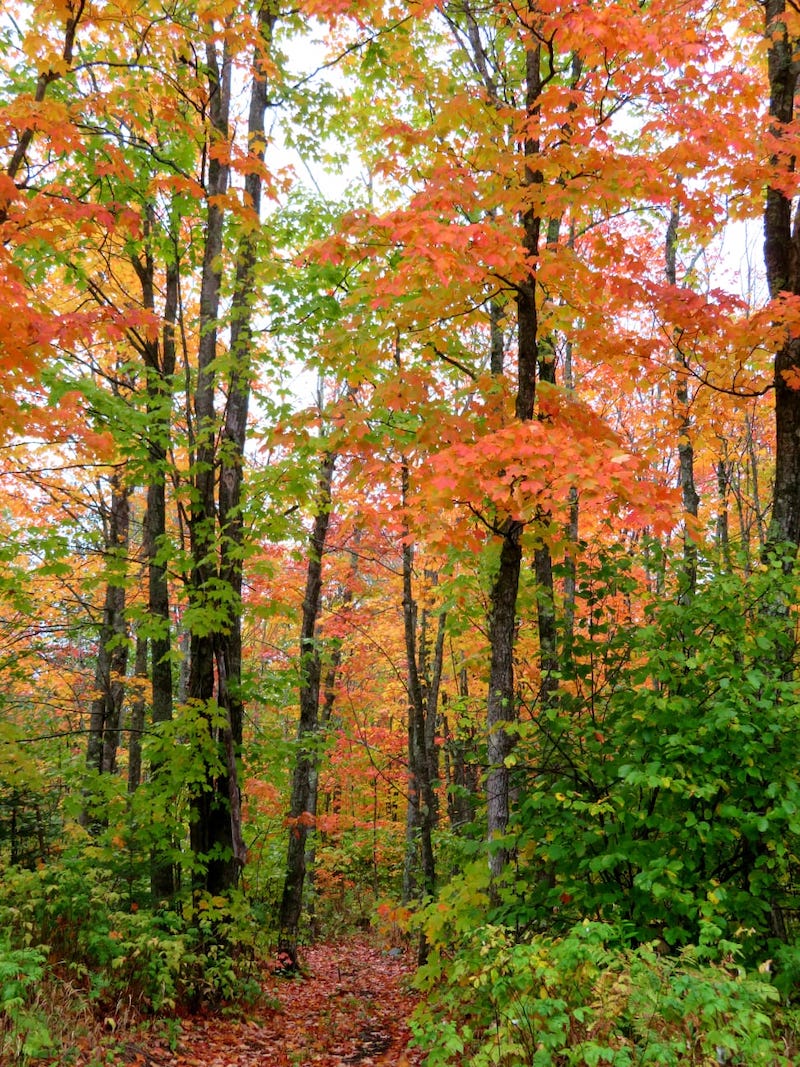 Northern part of Superior Hiking Trail in September.
Northern part of Superior Hiking Trail in September.
Common Concerns for New Backpackers
With my business, Backpack the Trails, I hear a lot of the same things from beginner backpackers. I try to address a lot of the insecurities people feel about backpacking and getting started on the sport.
First, I think a lot of people wonder if their fitness level is up to the challenge.
Second, people are often worried they’re going to hold up the group.
Third, people worry about their age or injuries.
When people hit the trails with me, I supply all of the gear and food, with over $2,000 of gear and provisions on each client’s back. So, while it might be a concern for newbies knowing which gear to use and food to bring when setting out on their own, it’s not something my clients need to worry about when they join me for a backpacking trip.
Generally, people are concerned about their age or the shape they’re in, whether they can complete a hike or just keep up with the group. I’ve had some older clients sign up for my trips who are in excellent shape, as well as younger clients who know they need to double-down on fitness before a trip. Some know that their body is slowing down or that they have accumulated injuries over time that could affect their ability to complete a trip.
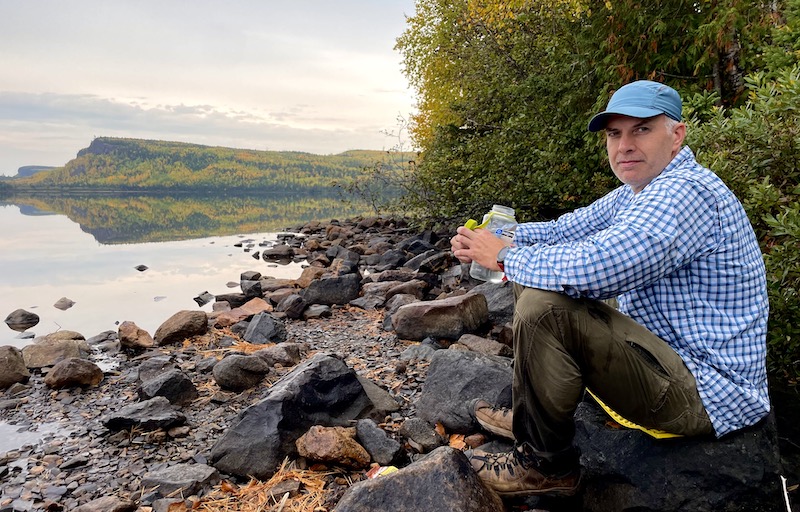 Backpack The Trails client sitting on bank at East Rose Lake portage in late September. Canada just across the lake.
Backpack The Trails client sitting on bank at East Rose Lake portage in late September. Canada just across the lake.
The Bare Minimum Gear You Need to Start Backpacking
Sometimes my clients have already started collecting gear because they knew they wanted to get into backpacking at some point. Things like a pack, sleeping bag, and mat. That’s great. I encourage them to go ahead and bring it so they can get dialed in on their own gear. I am always sure to go over their gear to ensure it is appropriate for the trail. I’m also teaching people about the gear they’ll need, not just how to backpack. My favorite pack is the ULA Circuit, favorite sleeping bags are any down bag from Western Mountaineering, and I love the quieter, tougher Therm-A-Rest ProLite series sleeping pads.
Even if clients want to try out their own gear, I still bring a whole kit for clients, in case they didn’t get their backpack properly fitted or their sleeping bag just doesn’t compress enough to fit into the backpack. I want to make sure that they’re comfortable on the trail. An hour in, you can start hating backpacking forever if your pack doesn’t fit right.
I bring a variety of gear on the trail so that people can see the difference between a $16 pot versus a $65 pot. This way, if they want to spend $1,000 to get started, or $2,000 to invest in the sport and pursue it, they have an idea of what’s available.
One of the things people worry about is pack weight. I try to keep each pack around 29 lbs. with three days of food and two liters of water.
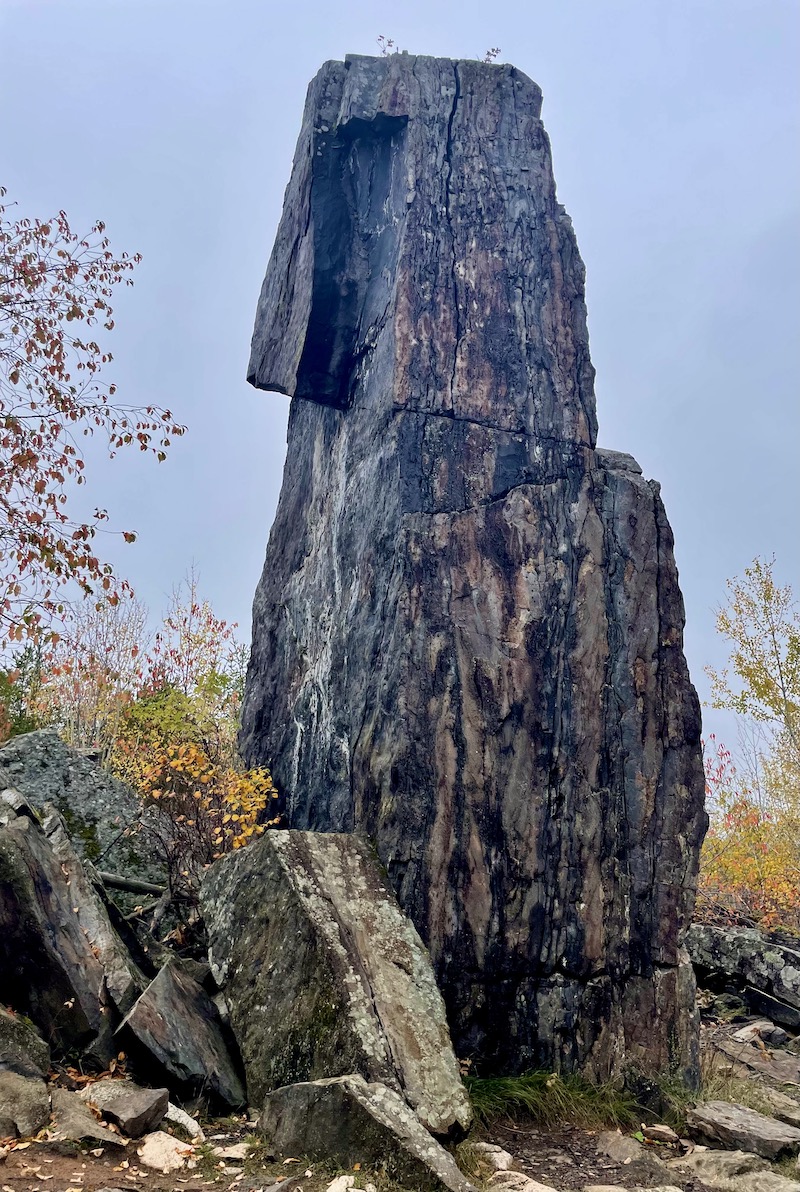 Magnetic Rock spotting 1.5 miles from end of western terminus on Border Route Trail. Popular day hike.
Magnetic Rock spotting 1.5 miles from end of western terminus on Border Route Trail. Popular day hike.
The biggest challenge for new backpackers is that they think they need a change of clean clothes every day. It kind of freaks people out when they realize they’ll actually end up wearing the same clothes day after day. The only change of clothes I will encourage people to carry are clean undies and a couple pairs of socks. Otherwise, carry your merino wool base layers, which are also the stuff you sleep in. Smartwool nails it. You also need to carry an insulated jacket and rain gear, maybe a sun-shirt and hat, and that’s really, truly it for clothes.
I do squeeze in a few luxury items, like an inflatable pillow. A foldable plate and an insulated cup are also favorite luxury items of mine. I always do a backpack fitting and a gear shake down the evening before we actually embark on the trip. Sometimes, people will squeeze in a lot of extra luxury items because they think that’s a good idea, but they soon realize that it just makes the pack a lot heavier.
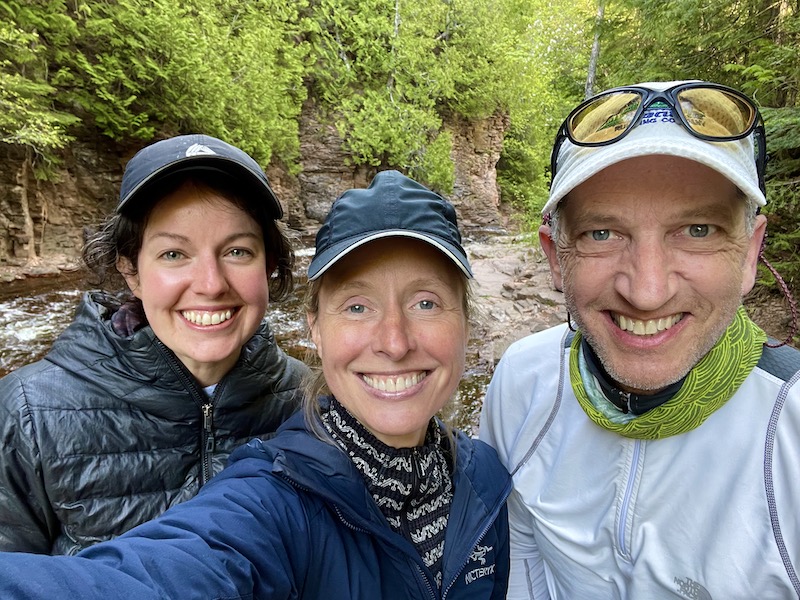 Backpack The Trails’ main guiding group with decades of combined outdoor experience. At West Devil Track River campsite. Owner – Michelle – in the middle.
Backpack The Trails’ main guiding group with decades of combined outdoor experience. At West Devil Track River campsite. Owner – Michelle – in the middle.
Tips for Packing Luxury Items on Long Hiking Trips
My top five recommended luxury items are pretty simple, really.
- I have what I call “the sacred butt pad of warmth.” It’s just a little sit pad.
- An inflatable pillow.
- An insulated cup.
- A lightweight, foldable plate.
- I bring really good food.
You know, you don’t need an inflatable pillow. It’s easy to use your sleeping bag stuff sack and just throw your hiking clothes and rain gear in there to use as a pillow. You can eat your meals right out of the pan, instead of from a plate. Just know that you’re going to end up having to hang it with the food at night. Same goes for the insulated cup.
Really good food, if done right, doesn’t really weigh that much more. It just takes time to get it dialed in. I would rather have too much food than not enough out there. Good caloric intake on the trail is really important. Outside Online has a great calorie calculator and explains why getting enough calories is important. And you always want to have a little extra food, in case you get stuck out there for a day. Northern Minnesota is known for some pretty horrendous storms. Those things creep up on us here pretty quickly.
Trim down the gear you pack to absolute essentials, with only a few small extras, if any. That will help you make sure you’re not miserable carrying unnecessary, heavy stuff.
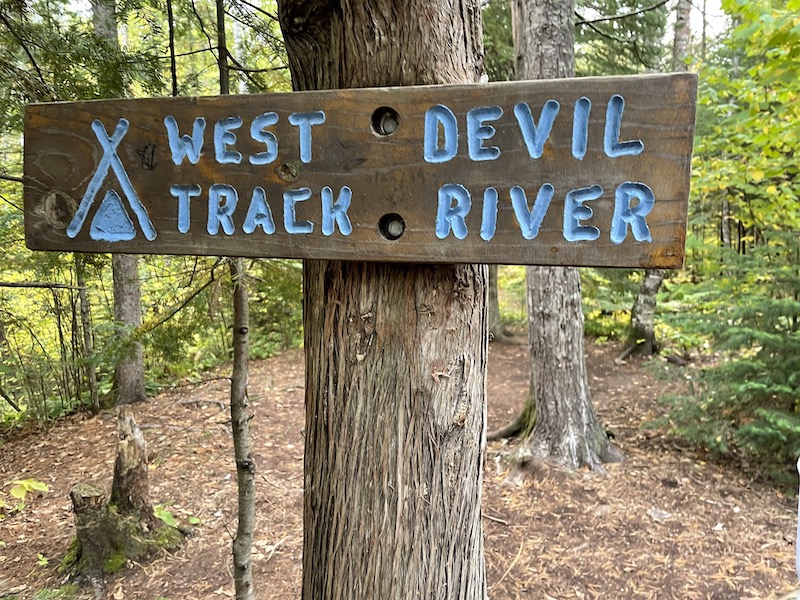 West Devil Track Campsite on Superior Hiking Trail. Enjoy sound of waterfalls while you rest and recover. FYI: campsites are smaller than campgrounds; they are not the same.
West Devil Track Campsite on Superior Hiking Trail. Enjoy sound of waterfalls while you rest and recover. FYI: campsites are smaller than campgrounds; they are not the same.
What to Pack For a Day Hike
I worked for an outdoor gear store for several years, and there are a lot of things that people miss putting in their packs for a day hike.
Day hikes are considered the most dangerous, because people aren’t prepared if something goes wrong. Here is a scenario: It’s heading toward evening, you are 2 miles in and are ready to turn around for the 45 minutes it’ll take to get back to your car, and you suddenly break your ankle. As you look around, it’s starting to cool off and it’s getting dark. Everyone else has already turned back, so one else is on the trail. You have no headlamp, no water filter, no jacket, and it starts to thunder. There is no cell service and you have no way to get help.
Here are the top items I think all day hikers should bring with them:
- Definitely rain gear. Marmot Precip is a great foundational level, and Arc’teryx makes some of the best on the market.
- An insulated jacket. Patagonia’s Micro Puff is great for cool Summer nights, as is Arc-Teryx’s Atom LT Hooded Insulated Jacket.
- Plenty of water, or a water filter or chemical water treatment. I like my Katadyn BeFree filter and always bring Aquamira’s chemical water treatment. Minnesota’s got a lot of water features, and I’ve heard a lot of people will just drink water from the lakes and rivers. Don’t do it. Waterborne illnesses are not fun, so make sure you’re filtering your water.
- Snacks. Always bring something to eat.
- An emergency blanket and basic first aid.
- Some kind of navigation as well as a map and compass.
- A way to contact the outside world or to trigger an SOS. I’m a huge proponent of my Garmin inReach Mini. I love that satellite messenger, and it weighs very little. If you do bring one, you need to learn how to use it.
Those are the key things I would recommend for a day hiker. You could carry a lot more stuff, even a full-size pack. But if you’re just going to do a little day hike in Minnesota, I would say this is probably enough. Be sure to always check weather forecasts before heading out.
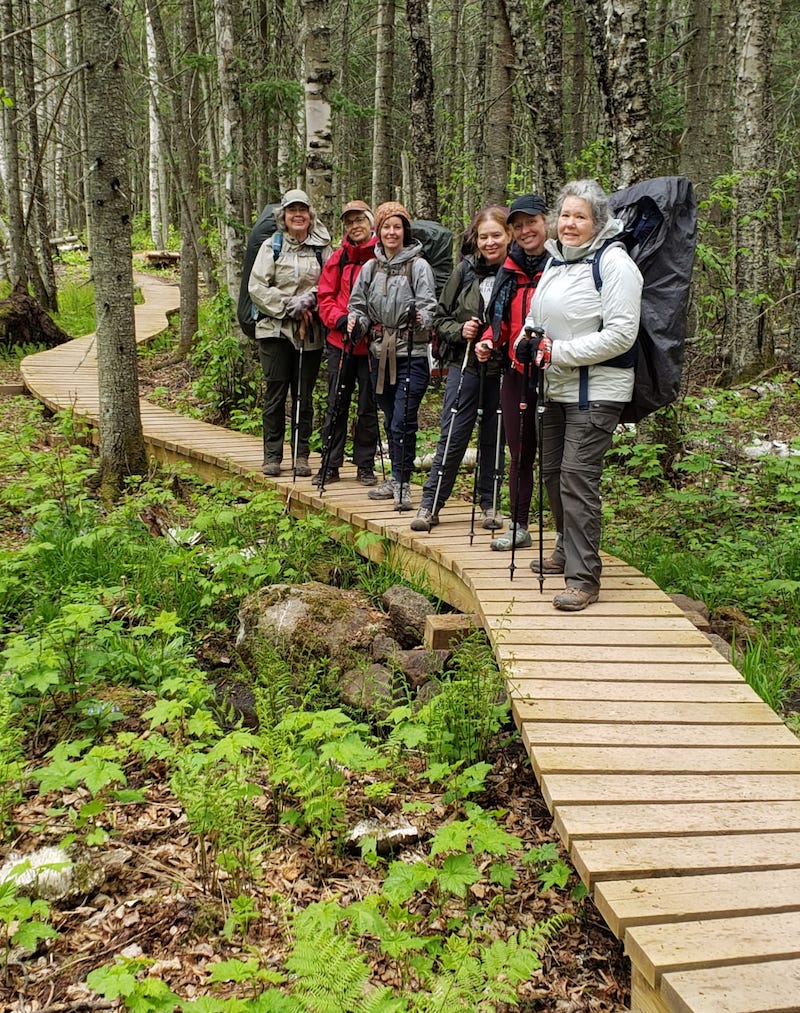 Backpack The Trails beginner group wrapping up section thru hike in late May. Standing on the new boardwalk by Grand Marais.
Backpack The Trails beginner group wrapping up section thru hike in late May. Standing on the new boardwalk by Grand Marais.
How to Pick the Best Rain Gear for Hiking
Gore-Tex is kind of the gold standard. There are also a lot of good-quality, proprietary waterproof membranes made by a lot of different companies that are available on the market.
First, you want to make sure you know the difference between waterproof and water-repellent. This is where I’ve seen the majority of errors. Speak with a great salesperson at your local outdoor outfitter, and be sure to do your own thorough research. For example, the folks at REI know their stuff. Here in Minnesota, Midwest Mountaineering is staffed with really knowledgeable people.
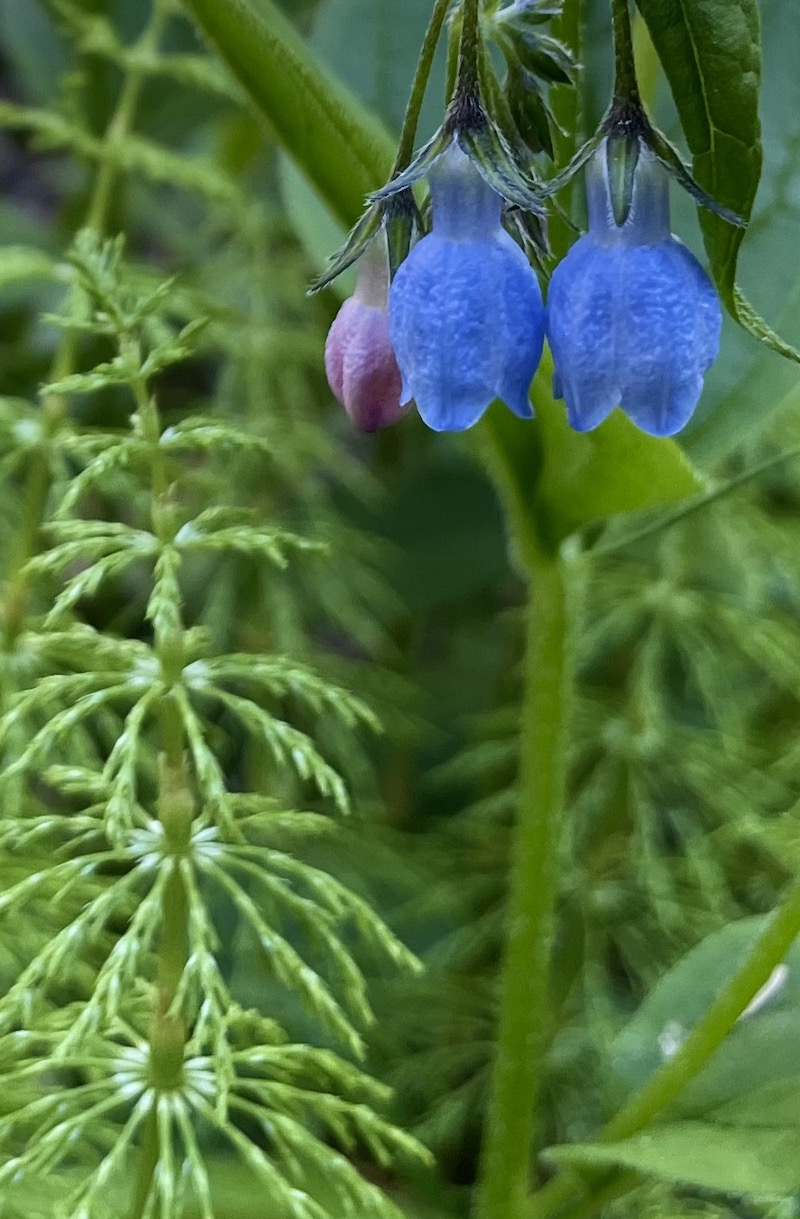 Summer foliage on Superior Hiking Trail.
Summer foliage on Superior Hiking Trail.
Buying things online can be a little risky; so can buying used.
Products with seam seals is usually a good sign that something is waterproof, but that’s not always 100%. On the inside, it looks like tape over the seam. You can have waterproof fabric, but the second the manufacturer pokes a needle through the fabric to stitch things together, that fabric is no longer waterproof. Hence, the need for seam seals. You could have inadvertently purchased faulty rain gear or your tried-and-true rain gear is worn out.
 Mid September view of the Devil Track River downstream from the campsite of Superior Hiking Trail.
Mid September view of the Devil Track River downstream from the campsite of Superior Hiking Trail.
I will sometimes do a quick test. I’ll make the hood of the jacket into a small bowl shape and add some water, close it up with my hands to create a small pouch, and then squeeze the pouch, trying really hard push water through the fabric to see if water seeps through. I can tell immediately if something is not waterproof.
That said, sometimes it can take time to completely soak a jacket that looks like it will function well, even when you do a quick-test. Unfortunately, if you rely only on a quick test or seam seals, you might sadly find out when you’re on the trail that your jacket doesn’t work. This is why it is so important to test your rain gear on a longer, rainy day hike that is not too far away from your vehicle or exit point.
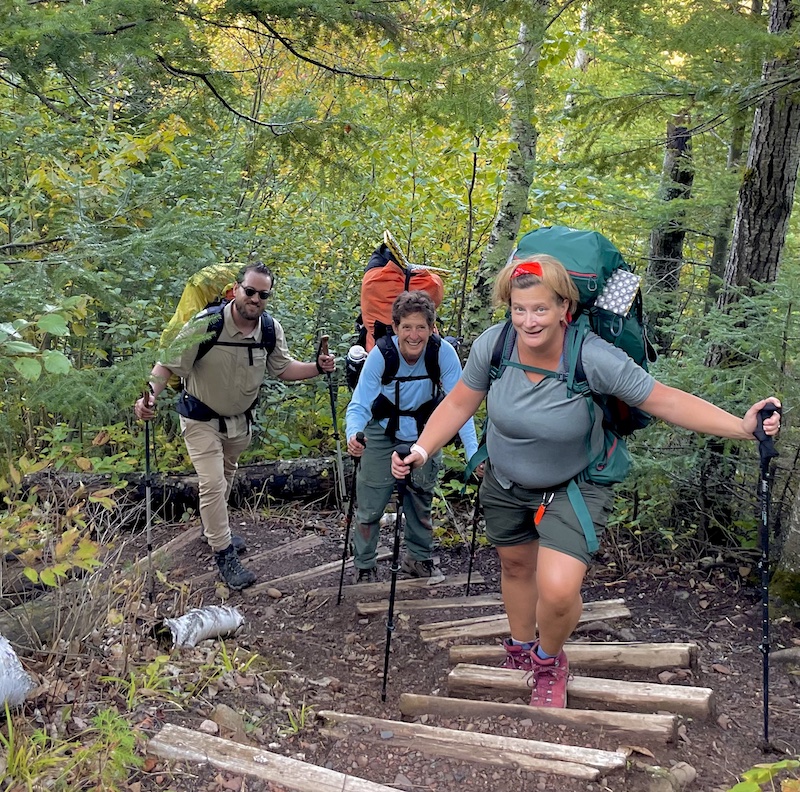 Backpack The Trails clients, beginner backpackers, ascending 144 stairs on SHT in mid September on the last day of the Superior Hiking Trail section thru hike.
Backpack The Trails clients, beginner backpackers, ascending 144 stairs on SHT in mid September on the last day of the Superior Hiking Trail section thru hike.
Also, know that dirt and other stuff can diminish the waterproof membrane overtime. There are different cleaning products out there for outdoor gear. Whether it’s your sleeping bag or your rain jacket, you want to make sure you’re using the right products to get them clean as well as re-waterproof them.
High-quality rain gear does tend to be more expensive because of the extra features it has. For example, make sure you’re buying a jacket with pit zips. It’s rare that it rains “upward,” so you can have the pit zips open to vent off sweat and body heat so that you don’t make your rain gear wet from the inside.
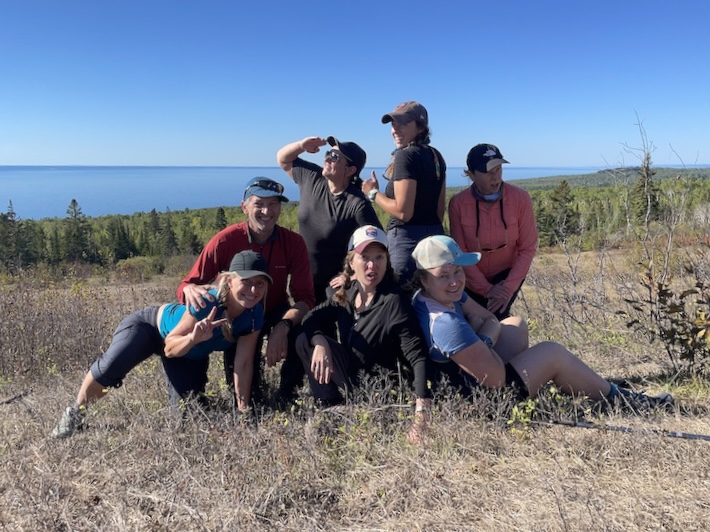 Final beginner backpacking trip in late September on Superior Hiking Trail. Goofing around on Wildflower Hill with Lake Superior in background.
Final beginner backpacking trip in late September on Superior Hiking Trail. Goofing around on Wildflower Hill with Lake Superior in background.
Tips for When Your Gear Fails
I always bring a big, beefy garbage bag along for any type of emergency. Whether the tent’s rain fly fails, a rain jacket soaks through, or something like that, you can just throw a garbage bag on as a safety measure.
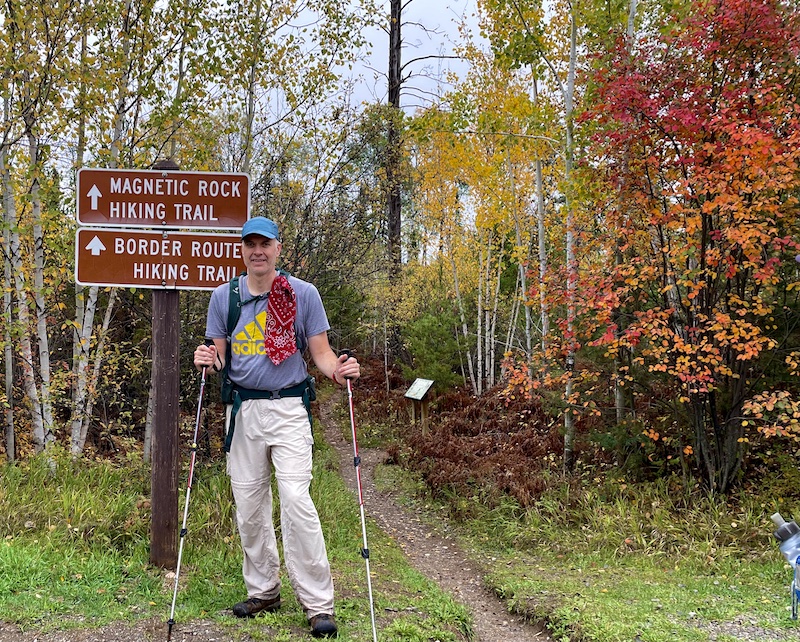 Backpack The Trails client ends the 65mi Border Route Trail at the western terminus in early October.
Backpack The Trails client ends the 65mi Border Route Trail at the western terminus in early October.
I also have another rule: If I’m bringing a down sleeping bag, I make sure that my insulated jacket is synthetic, or vice-versa. You want to make sure that you’ve got a last line of defense to be able to stay warm. If all of your stuff’s getting wet, you’ll want to make sure you’ve got some kind of synthetic layer, because synthetic insulation continues to insulate even when wet. Down does not. Having a synthetic-insulated layer really could be the thing that saves you.
Why Should Backpackers Travel with Backpack The Trails?
Learning how to backpack can be really rough, as well as expensive. My early backpacking experiences were a nightmare. Not only did I learn from my mistakes, I find these stories to be super relatable for people who are just starting out with backpacking, especially in a place like Minnesota.
Early on, I camped in an area where the mosquitoes were so bad they were swarming behind my glasses. It didn’t matter if I was breathing through my nose or my mouth, I had mosquitoes up my nose or in my mouth. I was hitting hundreds, probably three or four hundred of them, as I was walking along. It was awful. Some people in dry locations will never have this experience, but if you’re hiking or camping in a wet environment, swarms of bugs are often a reality. Real insect repellent matters, whether treating clothes ahead of time, or using repellent on the trail.
On that same trip, a bear stole our food because my boyfriend didn’t want to hang it. Rookie mistake.
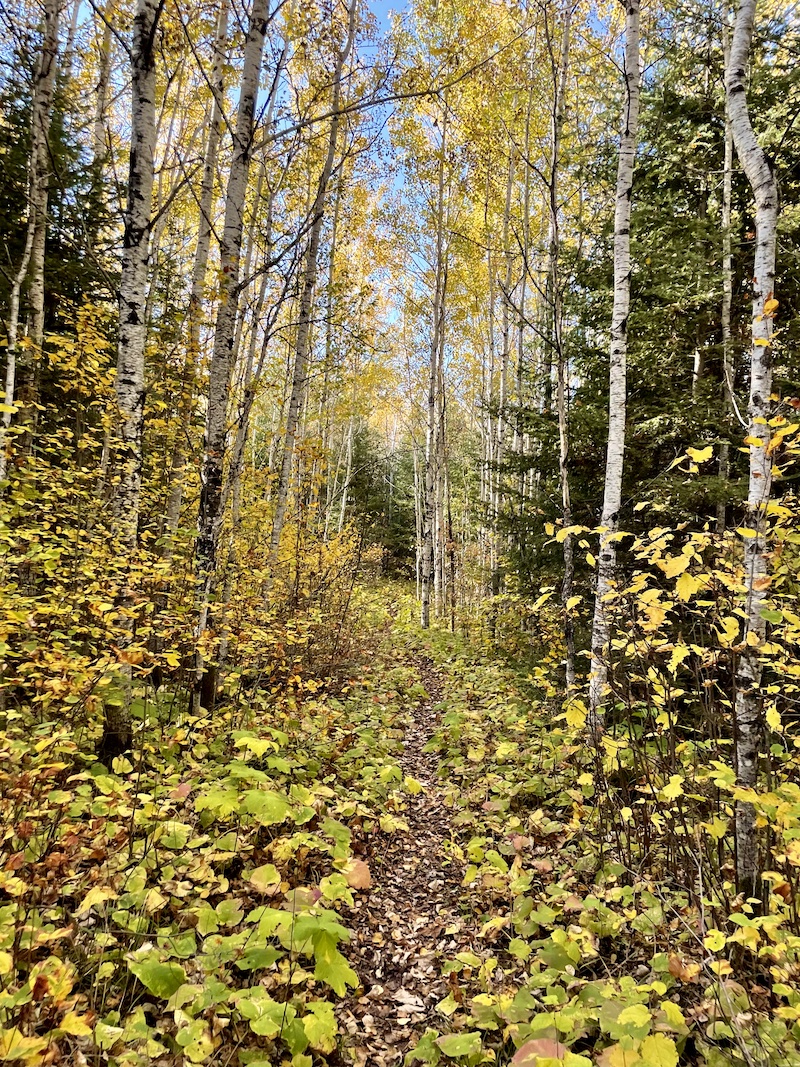 Beautiful colors on Border Route Trail in late September. Aspen, Balsam Fir, Spruce and maybe some Birch trees.
Beautiful colors on Border Route Trail in late September. Aspen, Balsam Fir, Spruce and maybe some Birch trees.
On another trip, both our camp stove and water filter broke. I made the mistake of wearing urban hiking boots instead of footwear made for trails. I had a pack that was about 45lbs, and I weighed about 103lbs then. Between the pack weight and the footwear, I thought I had stress fractures in my ankles; I was howling and in tears.
I share the knowledge I’ve accumulated as a hiker, backpacker, environmentalist, and wilderness first responder and make the backpacking experience educational and fun. This is why I started Backpack The Trails.
I also provide all of the backpacking gear for my clients as well as all of the food. This makes it easier to get started and helps clients figure out what they need, without having to buy all the gear or guess at food for the trail.
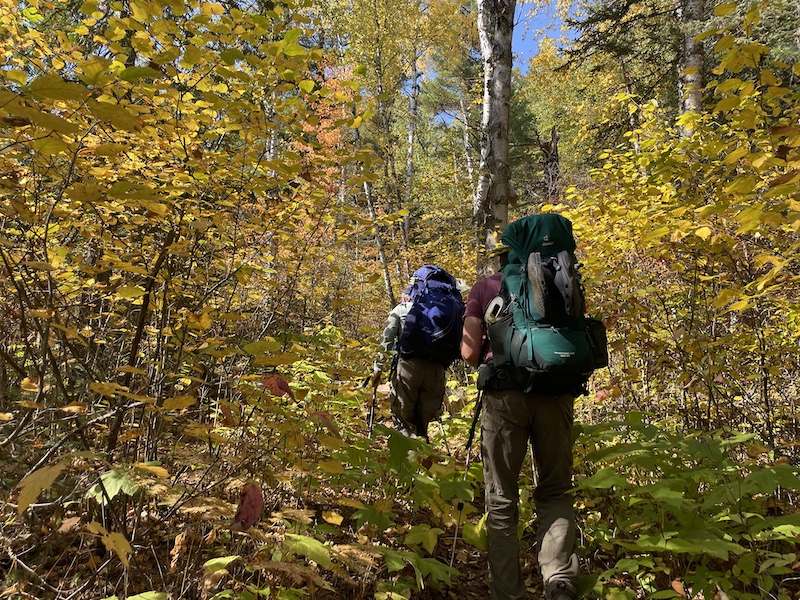 Backpack The Trails’ clients hiking on the Border Route Trail in late September.
Backpack The Trails’ clients hiking on the Border Route Trail in late September.
My clients feel I am giving them a gift by opening opportunities for them to experience the outdoors through backpacking. But really, it’s an amazing gift for me to see the transformation in people and the experiences that they have out there. They gain a sense of empowerment and astonishment that, in some ways, backpacking is really easy.
It’s really fun to watch people learning how to backpack, and then see what new challenges they take on afterwards. I’ve had two clients who, right after their first time backpacking, went off and tackled solo trips, one covering the entire Superior Hiking Trail solo, and another backpacking by herself in the Wind River Range and Titcomb Basin. I also offer intermediate and advanced trips around the U.S. for clients who want to continue to expand their experience with support. It’s so rewarding to see them learn and grow as backpackers over several trips.
To share the beauty with people, it’s really exhilarating for me. I absolutely love it.
